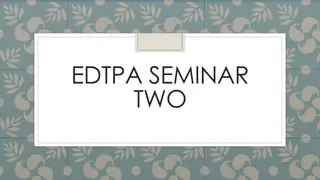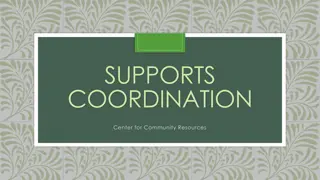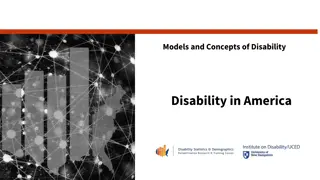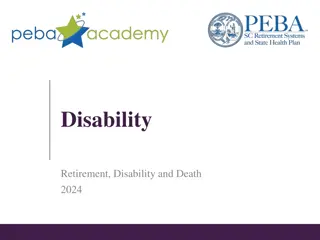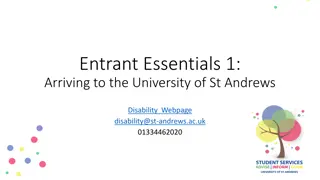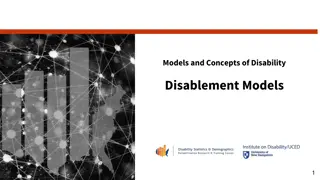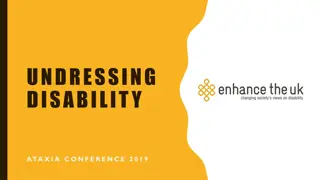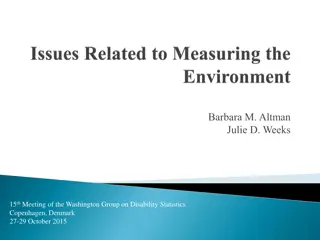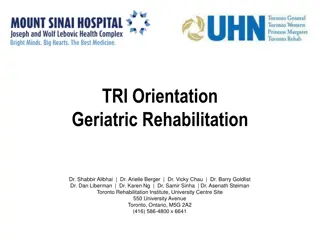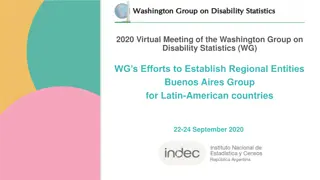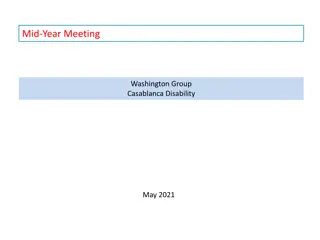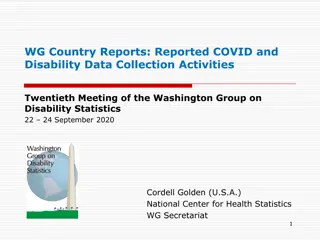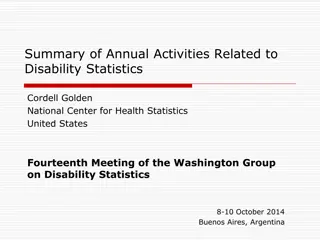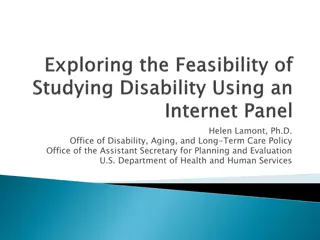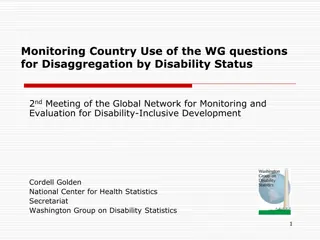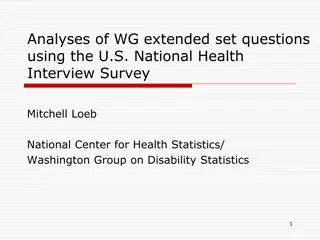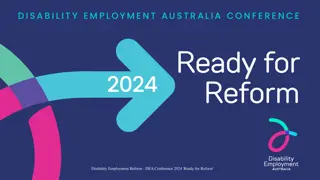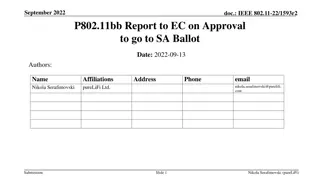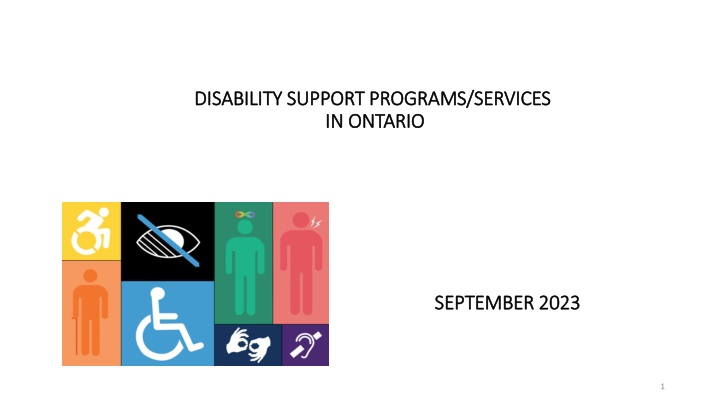
Disability Support Programs and Services in Ontario September 2023
Discover disability support programs and services available in Ontario in September 2023, including Federal programs like the Registered Disability Savings Plan (RDSP), Disability Tax Credit (T2201), and more. Learn about the benefits and eligibility criteria for these important resources.
Download Presentation

Please find below an Image/Link to download the presentation.
The content on the website is provided AS IS for your information and personal use only. It may not be sold, licensed, or shared on other websites without obtaining consent from the author. If you encounter any issues during the download, it is possible that the publisher has removed the file from their server.
You are allowed to download the files provided on this website for personal or commercial use, subject to the condition that they are used lawfully. All files are the property of their respective owners.
The content on the website is provided AS IS for your information and personal use only. It may not be sold, licensed, or shared on other websites without obtaining consent from the author.
E N D
Presentation Transcript
DISABILITY SUPPORT PROGRAMS/SERVICES DISABILITY SUPPORT PROGRAMS/SERVICES IN ONTARIO IN ONTARIO SEPTEMBER 2023 SEPTEMBER 2023 1
DISABILTY SUPPORTS IN ONTARIO Federal Programs Registered Disability Savings Plan (RDSP) Disability Tax Credit (T2201) Child Disability Benefit (Monthly) Canadian Housing Mortgage Corp. (CHMC) CRA Medical Expenses CRA Caregiver Tax Credit Disability Supports Deduction. Individuals who have an impairment in physical or mental functions and have paid for certain medical expenses can, under certain conditions, claim the disability supports deduction. CPP Disability, Child and Survivor Benefits 2
RDSP Registered Disability Saving Plan RDSP Registered Disability Saving Plan Registered Disability Savings Plan https://www.canada.ca/en/employment-social-development/programs/disability/savings/grants-bonds.html The Registered Disability Savings Plan (RDSP) is a long-term savings plan to help Canadians with disabilities and their families save for the future. If you have an RDSP, you may also be eligible for grants and bonds to help with your long-term savings. You should consider opening an RDSP if you have a long-term disability and are: eligible for the Disability Tax Credit; under the age of 60 (if you are 59, you must apply before the end of the calendar year in which you turned 59); a Canadian resident with a Social Insurance Number (SIN); and looking for a long- term savings plan. You may contribute any amount to your RDSP each year, up to the lifetime contribution limit of $200,000. With written permission from the RDSP holder, anyone may contribute to the RDSP. Canada Disability Savings Grant The Canada Disability Savings Grant is a matching grant. That means that the Government also pays into your RDSP to help you save. The Government gives matching grants of up to 300 percent, depending on the beneficiary's family income and contribution. The maximum Grant amount is $3,500 per year, with a limit of $70,000 over your lifetime. Matching grants are paid into the RDSP on contributions that are made up to and including December 31 of the year you turn 49 years of age. Canada Disability Savings Bond The Canada Disability Savings Bond is money the Government contributes to the Registered Disability Savings Plans (RDSPs) of low- and modest-income Canadians. If you qualify for the Bond, you can receive up to $1,000 a year, depending on the beneficiary s family income. Over an individual s lifetime, there is a limit of $20,000. Bonds are paid into the RDSP if an application has been made on or before December 31 of the year the beneficiary turns 49 years of age. You do not need to make any contributions to your RDSP to receive the Bond. 3
DISABILITY TAX CREDIT - T2201 https://www.canada.ca/en/revenue-agency/services/tax/individuals/segments/tax-credits-deductions- persons-disabilities/disability-tax-credit.html What is the Disability Tax Credit (DTC)? Applicants can now complete Part A of the DTC application using the new digital form. The disability tax credit (DTC) is a non-refundable tax credit that helps people with impairments, or their supporting family member, reduce the amount of income tax they may have to pay. If you have a severe and prolonged impairment, you may apply for the credit. If you are approved, you may claim the credit at tax time. Applying for the Tax Credit T2201 This involves you and a medical practitioner who can certify the effects of your impairment. If you are applying for the first time, and are approved, the tax credit will be adjusted back for a ten-year period. This adjustment will reduce your tax amount each year. In addition, if you receive(d) the Child Tax Credit, the benefits will be adjusted, based on the new yearly income. DTC Non refundable tax credit amount for 2022: If you are approved for the disability tax credit (DTC), you may be able to claim the disability amount of $8,870 on line 31600 of your 2022 tax return (in Step 5 of your T1). 4
Disability Tax Credit - T2201 Supplement for Children with Disabilities Supplement for Children with Disabilities If you were 17 years or younger at the end of 2022 and qualify for the disability amount, you may claim up to an additional $5,174. This supplement may be reduced if one of the following applies: Someone claimed child - care expenses (line 21400) or attendant care expenses (line 33099 or 33199) for you on their tax return. You claimed attendant care expenses (line 21500 or line 33099) on your tax return. By reducing the amount of income tax, you may have to pay, the DTC aims to offset some of the extra costs related to the impairment. It is critical that you apply for the DTC as it opens the door to other Benefits: RDSP Registered Disability Savings Plan CRA Eligible Medical Expenses Credit Child Disability Benefit (An additional monthly benefit). Every July, your CDB payments are recalculated based on your AFNI (adjusted family net income) from the previous year. For example, July 2023 to June 2024 payments is based on your income from your 2022 tax return; and July 2022 to June 2023 payments are based on your income from your 2021 tax return. For the period of July 2023 to June 2024, you could get up to $3,173 ($264.41 per month) for each child who is eligible for the DTC. 5
Disability Tax Credit - T2201 Supplement for Children with Disabilities Page 3 To receive this benefit, you must have the DTC Disability Tax Credit T2201, approved and on file with CRA. A child is eligible for the DTC when a medical practitioner certifies, on Form T2201, Disability Tax Credit Certificate, that the child has a severe and prolonged impairment in physical or mental functions, and the Canada Revenue Agency (CRA) approves the form. You can send the form to the CRA at any time during the year. Overview The Child Disability Benefit (CDB) is a tax-free monthly payment made to families who care for a child under age 18 with a severe and prolonged impairment in physical or mental functions. Eligibility To get the CDB: You must be eligible for the Canada child benefit (CCB) Your child must be eligible for the disability tax credit (DTC) If you are already getting the CCB for your child who is eligible for the DTC, you do not need to apply for the CDB. You will get it automatically. How Much Can You Receive? Your CDB Payments Are Calculated Using the Following Information: Number of eligible children Adjusted family net income (AFNI) Marital status Every July, your CDB payments are recalculated based on your AFNI from the previous year. For example, July 2023 to June 2024 payments is based on your income from your 2022 tax return; and July 2022 to June 2023 payments are based on your income from your 2021 tax return. For the period of July 2023 to June 2024, you could get up to $3,173 ($264.41 per month) for each child who is eligible for the DTC. The benefit starts being reduced when the adjusted family net income is greater than $75,537. The reduction is calculated as follows: For families with one child eligible for the benefit, the reduction is 3.2% of the amount of adjusted family net income greater than $75,537. 6 For families with two or more children eligible for the benefit, the reduction is 5.7% of the amount of adjusted family net income greater than $75,537.
CAREGIVER TAX CREDIT 2022 - 2023 What is the Canada Caregiver Credit? Do you support a spouse or common-law partner, or a dependent with a physical or mental impairment? The Canada caregiver credit (CCC) is a non-refundable tax credit that may be available to you. Who can you claim this credit for? You may be able to claim the CCC if you support your spouse or common-law partner with a physical or mental impairment. You may also be able to claim the CCC if one or more of the following individuals depend on you for support because of a physical or mental impairment: Your (or your spouse's or common-law partner's) child or grandchild Your (or your spouse's or common-law partner's) parent, grandparent, brother, sister, uncle, aunt, niece, or nephew (if they resided in Canada at any time in the year) An individual is considered to depend on you for support if they rely on you to provide them regularly and consistently with some or all the basic necessities, of life, such as food, shelter, and clothing. https://www.canada.ca/en/revenue-agency/services/tax/individuals/topics/about-your-tax-return/tax-return/completing-a-tax-return/deductions-credits- expenses/canada-caregiver-amount.html 7
CAREGIVER TAX CREDIT 2022 2023 Page 2 What amount can you claim? The amount you can claim depends on your relationship to the person you are claiming the CCC for, your circumstances, the person s net income, and whether other credits are being claimed for that person. For your spouse or common-law partner, you may be entitled to claim an amount of $2,350 in the calculation of line 30300. You could also claim an amount up to $7,525 on line 30425. For an eligible dependent 18 years of age or older (who is a person you are eligible to make a claim for on line 30400), you may be entitled to claim an amount of $2,350 in the calculation of line 30400. You could also claim an amount up to $7,525 on line 30425. See the note below (2023 CRA)) For an eligible dependent under 18 years of age at the end of the year (who is a person you are eligible to make a claim for on line 30400), you may be entitled to claim an amount of $2,350 in the calculation of line 30400 or on line 30500 for your child. See the note below. (2023 CRA) For each of your or your spouse s or common-law partner s children under 18 years of age at the end of the year, you may be entitled to claim an amount of $2,350 on line 30500. See the note below. For each dependent 18 years of age or older who is not your spouse or common-law partner or an eligible dependent whom an amount is claimed for on line 30300 or line 30400, you may be entitled to claim an amount up to $7,525 on line 30450. What documents do you need to support your claim? When you file your tax return, do not send any documents. Keep them in case the CRA asks to see them later. The CRA may ask for a signed statement from a medical practitioner showing when the impairment began and what the duration of the impairment is expected to be. For children under 18 years of age, the statement should also show that the child is, and will likely continue to be, dependent on others for a long and continuous period because of an impairment in physical or mental functions. (Dependent, on others means that the child needs much more help for their personal needs and care compared to children of the same age.) You do not need a signed statement from a medical practitioner if the CRA already has an approved Form T2201, Disability Tax Credit Certificate, for a specified period. 8
CPP DISABILTY CHILD AND SURVIVOR BENEFIT Is a taxable monthly payment that is available to people who have contributed to the CPP and who are not able to work regularly because of a disability. A monthly benefit for dependent children (under age 18 or between 18 and 25 and attending school full time) The Canada Pension Plan (CPP) children's benefits provide monthly payments to the dependent children of disabled or deceased CPP contributors. The child must be either: under age 18; or under age 25 and in full-time attendance at a recognized school or university. There are two types of CPP children s Benefits: A disabled contributor's child's benefit a monthly payment for a child of the person receiving a CPP disability benefit. A surviving child's benefit a monthly payment for a child of the deceased contributor. For the benefit to be paid, the deceased contributor must have made sufficient contributions to the CPP. A maximum of two children s benefits can be paid to a child Note: Once children turn 25, they are no longer eligible for these benefits. How much could a child receive? The monthly children's benefit is a flat rate that is adjusted annually. In 2022, the rate is $281.73 (2023) https://www.canada.ca/en/services/benefits/publicpensions/cpp/cpp-childrens-benefit.html 9
DISABILTY SUPPORTS DEDUCTION Line 21500 Disability Supports Deduction Individuals who have an impairment in physical or mental functions and have paid for certain medical expenses can, under certain conditions, claim the disability supports deduction. Eligibility Criteria If you have an impairment in physical or mental functions, you may be able to deduct the expenses that you paid in the year so that you could: Work Go to school Do research for which you received a grant List of eligible expenses: https://www.canada.ca/en/revenue-agency/services/tax/individuals/topics/about-your-tax-return/tax- return/completing-a-tax-return/deductions-credits-expenses/line-215-disability-supports-deduction.html Expense Attendant care expenses Bliss symbol boards Braille note-taker devices Prescription needed? See details Yes Yes Written certification from a medical practitioner needed? See details No No 10
CRA ELIGIBLE MEDICAL EXPENSES Lines 33099 and 33199 Eligible medical expenses you can claim on your tax return https://www.canada.ca/en/revenue-agency/services/tax/individuals/topics/about-your-tax-return/tax-return/c List of common medical expenses This list of common medical expenses shows: of medical expenses If the expense is eligible If you need any supporting documents (such as Form T2201, Disability Tax Credit Certificate) This list is not exhaustive. You can use the search feature of this list to quickly find a specific medical expense. For more information on eligible medical expenses. Medical expense Eligible expense? Prescription needed. Certification in writing needed? Form T2201 needed? Acoustic coupler Eligible Yes No No Air conditioner Eligible Yes No No Air filter, cleaner, or purifier Eligible Yes No No 11
DISABILTY SUPPORTS IN ONTARIO Provincial Programs Birth to Age 18 Assistance for Children with Severe Disabilities (ACSD) Special Services at Home (SSAH) Ontario Autism Plan (December 2021) www.children.gov.on.ca/htdocs/English/.../autism/ontario-autism- program.aspx ODSP Ontario Disability Support Program OPHI Ontario Priorities Housing Imitative Age 18 and Over DSO Disability Services Ontario Passport 13
ACSD ASSISTANCE FOR CHILDREN WITH SEVERE DISABILITIES. If you are a parent caring for a child with a severe disability, you may be able to receive financial support through the Assistance for Children with Severe Disabilities Program. This program provides financial support for low- to moderate-income families to cover some of the extra costs of caring for a child who has a severe disability. https://www.ontario.ca/page/assistance-children-severe-disabilities-program Eligibility A parent or a legal guardian whose child: Is under 18 years of age, Lives at home, and has a severe disability May be eligible to receive help under this program depending on the family's income. ($74,760 or less) ** Financial Support Depending on the income and size of the family, the program may provide between $25 and $618.00 (July 2023) a month to help with costs, such as: Travel to doctors appointments, hospitals and other appointments related to the child s disability Special shoes and clothes Parental relief such as respite Wheelchairs and other assistive devices, including repairs Hearing aids and batteries Prescription drugs Dental and vision care, including eyeglasses 14
SSAH SPECIAL SERVICES AT HOME https://www.ontario.ca/page/special-services-home The Special Services at Home program helps families who are caring for a child with a developmental and/or physical disability. It is funded and managed by the Ministry of Community and Social Services. The program helps families pay for special services in or outside the family home as long as the child is not receiving support from a residential program. For example, the family can hire someone to: Help the child learn new skills and abilities, such as improving their communications skills and becoming more independent Provide respite support to the family - families can get money to pay for services that will give them a break, or respite, from the day-to-day care of their child. The amount of funding a family receives depends on: The type and amount of service the child needs What other help is available in the community What kind of support the family is already receiving. Eligibility Families can apply for this support if their children have a developmental and/or physical disability: Live in Ontario; and, Need more support than most families can provide And are living at home with their family, or If they are not living at home with their family and are not being helped by other residential services 15
ONTARIOAUTISM PROGRAM Page 1 https://www.ontario.ca/page/ontario-autism-program About the Ontario Autism Program The Ontario Autism Program (OAP) offers support to families of children and youth on the autism spectrum. Children and youth who have been diagnosed with autism spectrum disorder (ASD) by a qualified professional are eligible for the program. Children receive services and supports until the age of 18. AccessOAP AccessOAP is the Ontario Autism Program s Independent Intake Organization that supports everyone registered in the Ontario Autism Program. AccessOAP care coordinators are available to: Answer your questions Help you understand your service options Help you access needs-based services and supports in your community Creating an AccessOAP account If you are new to the OAP, please create an AccessOAP account to register for the program and get support. 16
ONTARIO AUTISM PROGRAM Page 2 Eligibility To register for the Ontario Autism Program, your child must: Be under age 18 Currently live in Ontario Have a written diagnosis of autism from a qualified professional Your child s written diagnosis must include: Your child s full name and date of birth The date of your child s assessment A statement indicating that the child meets the diagnostic criteria for autism spectrum disorder The qualified professional s name and credentials 17
ONTARIO AUTISM PROGRAM Page 3 I Interim One-Time Funding https://www.ontario.ca/page/ontario-autism-program#section-0 Learn about interim one-time funding for children and youth who registered in the Ontario Autism Program before April 2021, including eligibility, how to apply and how to report expenses. Overview Children and youth who registered in the Ontario Autism Program before April 2021 might be eligible for interim one-time funding. All eligible families who submitted their registration form and supporting documentation by March 31, 2021, will receive funding to purchase eligible services and supports. The amount you are eligible to receive is based on your child or youth s age as of April 1, 2023: $22,000 for a child under the age of 6 $5,500 for a child or youth aged 6 17 If you received an invitation to apply for interim one-time funding and you apply within the 90-day window in the letter, we will honour the funding determination date in the letter. Each eligible child and youth can also renew their funding once. You cannot get more than two interim one-time funding payments. Accepting this funding will not impact your eligibility for the needs-based program. Your child or youth will enter core clinical services in the order that they registered for the Ontario Autism Program. 18
ONTARIO AUTISM PROGRAM Page 4 Childhood Budgets Update As of July 1, 2022, additional funding is available to children and youth: Who have a current funding agreement for childhood budgets and interim one-time funding enter a new funding agreement for childhood budgets and interim one-time funding We are providing this additional funding to support the Personal Support Workers and Direct Support Workers Permanent Compensation Enhancement Program. . Purchasing autism services with a childhood budget Families received their childhood budget funding within four weeks of the ministry reviewing their completed applications and documentation. Soon after we sent your childhood budget funding, we also mailed you a package with more details about: Once you received your funding, you could start purchasing eligible Ontario Autism Program services. Services or supports purchased before you received your cheque cannot be covered by your childhood budget 19
Ontario Autism Program Page 4 Behaviour Plans Overview An Ontario Autism Program behaviour plan (or plan) provides a detailed description of the evidence-based behavioural services that a child or youth receives in the Ontario Autism Program (OAP). A behaviour plan is developed through collaboration between the family, the OAP clinical supervisor and other professionals as necessary. While some families may receive multiple types of service, the OAP behaviour plan focuses exclusively on the evidence-based behavioural services that the child or youth is receiving through the OAP. Families receiving childhood budgets are not required to submit behaviour plans to receive funding. Families may continue to find it valuable to have their child s clinical supervisor develop an individualized behavioural service plan. 20
ODSP ONTARIO DISABILTY SUPPORT PROGRAM If you have a disability and need help with your living expenses, you may be eligible for the Ontario Disability Support Program (ODSP). ODSP Offers: Financial assistance to help you and your family with essential living expenses Benefits, for you and your family, including prescription drugs and vision care ODSP offers Two Types of Support: Income support - Financial assistance provided each month to help with the costs of basic needs, like food, clothing and shelter. Income support also includes benefits, like drug coverage and vision care, for clients and their eligible family members. Employment supports - Services and supports to help clients with disabilities find and keep a job and advance their careers. 21
ODSP ONTARIO DISABILTY SUPPORT PROGRAM Page 2 ODSP SHELTER VS BOARDER RATES What is Board and Lodging Do you know the difference between Renter vs Boarder ODSP payment rates? Many of our children are automatically assigned Boarder rates when we apply for ODSP, instead of Renter. The difference between to two rates is: 1. $1308.00 per month for Shelter (Renter) and Basic Needs July 2023 vs 2.$924.00 per month for Boarder and Basic Needs. What is Shelter ODSP Shelter is defined as the cost for a dwelling place used as a principal residence. Allowable shelter costs for a principal residence include rent, principal and interest on a mortgage or loan, occupancy costs paid under an agreement to purchase, taxes, utilities, heat, water, sewage and insurance premiums for the dwelling place or its contents. https://www.ontario.ca/document/ontario-disability-support-program-policy-directives-income- https://www.ontario.ca/document/ontario-disability-support-program-policy-directives-income-support/61-basic-needs A board and lodging situation is one in which a recipient receives food and shelter from the same source In situations where the recipient's circumstances are not clearly defined as either rent or board and lodging, the shelter arrangement is determined by reviewing the recipient's food preparation practices. If the landlord purchases and prepares the food, the recipient is a boarder. March 28, 2022 if the landlord purchases and prepares the food, the recipient is a boarder. If the recipient purchases and prepares food separately for himself/herself and his/her dependent s, then the recipient is in a rental situation. To be considered a renter, a recipient does not necessarily need to be living in self-contained quarters but must purchase and prepare his/her own food. If your child lives with you and he/she can help with food prep, purchasing of food, and budgeting to increase their ADL (Activity of Daily Living) skills. To ensure quality of life and skills development, they can qualify for the full Rental/Basic Needs ODSP Funding. 22
ODSP ONTARIO DISABILTY SUPPORT PROGRAM Page 3 Ontario Disability Support Program Employment Supports If you have a disability, Ontario Disability Support Program (ODSP) employment supports may help you find work, keep a job, start a business what is ODSP employment and training Start Up Benefit? Employment and Training Start-up Benefit: ODSP can reimburse expenses related to starting a new job or job training program, up to $500 in a 12-month period. Transportation Allowance: ODSP can help pay for travel and transportation costs (e.g., cab, bus fare, etc.)r advance your career. Community-based service providers deliver ODSP employment supports. New Rules for Earning and Annual Rate Increases Tied to Inflation As of February 1, 2023, if you are a person with a disability, you can earn up to $1,000 a month through employment without it affecting your ODSP income support, benefits or eligibility. This change will be reflected in the March 2023 payment. ODSP rates are now tied to inflation. In any year that payments go up, you will receive the higher payment at the end of July of each year. RDSP income not considered income for ODSP purposes 23
ODSP DISABILTY SUPPORT PROGRAM Page 4 Ontario Disability Support Program Health and Disability Benefits Overview ODSP provides many health benefits and disability-related benefits. These benefits can help you with many different types of costs, including health, dental, vision, assistive devices, and other expenses related to disability or medical conditions. Special Diet Allowance https://www.ontario.ca/document/ontario-disability-support-program-policy-directives-income-support/64-special-diet Summary of Policy Each member of the benefit unit may receive an allowance to assist with the cost of a special diet for a medical condition listed on the Special Diets Schedule. An approved health care professional must confirm that the member has a medical condition for which a special diet allowance is provided. The Special Diet Allowance is provided to recipients and their dependents, who receive either basic needs/shelter allowance, or the board and lodging amount. The maximum Special Diet Allowance is $250 per month, per member of the benefit unit. The Special Diet Allowance is a component of the budgetary requirements of a benefit unit. 24
DSO DISABILITY SERVICE ONTARIO PASSPORT FUNDING Any adult who is eligible for developmental services and supports funded by the Ministry of Community and Social Services, including young adults who are 18 years of age and still in school, may apply for funding through Passport. https://www.mcss.gov.on.ca/documents/en/mcss/publications/developmental/passport/Passport_Program_Guidelines-en.pdf The reimbursement program that helps adults with developmental disabilities in Ontario access services and supports. Once you are eligible for adult developmental services, you will receive the initial funding of $5,500 a year; and the amount increases based on your DSO Assessment rating; up to a maximum of $44,275 (Jan 9, 2022). This funding can help you participate in community services and support, daily living activities, and person-directed planning. It can help you become more involved in your community and live more independently. To apply for adult developmental services, funded by the Ministry of Children Community and Social Services (MCCSS) through Developmental Services Ontario (DSO), you will need to prove that you have a developmental disability, live in Ontario, and are 18 years old. The criteria reviewed are: Cognitive Functioning, Adaptive Functioning, Age of Onset and a history of requiring Habilitative Support. The person has an overall score of two standard deviations below the mean, plus or minus standard error measurement, on a standardized intelligence test; or The person has a score of two standard deviations below the mean in two or more subscales on a standardized intelligence test and the person has a history of requiring habilitative support; or Based on a clinical determination made by a psychologist or a psychological associate, the person demonstrates significant limitations in cognitive functioning and the person has a history of requiring habilitative support. 25
DSO DISABILITY SERVICE ONTARIO PASSPORT FUNDING Page 2 What can I use the funding for? Community participation and activities of daily living Programs, classes, and supports that help develop independence, social and life skills (e.g., literacy, cooking, managing money, computer skills, assistance with personal care needs) Participation in community activities and events (e.g., recreation, club memberships, admission to festivals and museums, sports) Pre-employment and employment support (e.g., skills training, resume development and job coaching) Transportation for employment and admissible activities (e.g., transit, mileage, taxis) Paying a support worker to help with community participation and daily living activities. This includes a support worker s expenses while providing support (e.g., transportation and activity fees, expenses for accompanying the individual during trips) Caregiver Respite Caregiver respite is temporary help to provide a break to primary caregivers. This can be during the day, evening, or weekend, and can be in-home or out-of-home. Person-Directed Planning Funding (up to $2,500) can be used to develop a person-directed plan that builds on the individual s strengths and interests and identifies support to help them achieve their goals. These supports can be purchased from independent planners, facilitators, or developmental services agencies. 26
DSO DISABILTY SERVICE ONTARIO PASSPORT FUNDING Administration Funding can cover some employer costs (e.g., Canada Pension Plan contributions, Employment Insurance, etc.) and some administrative supports (e.g., bank fees, bookkeeping, etc.). Page 3 Technology Funding (up to $3000) can be used for technology products and services (e.g., laptops or tablets, cell phones and plans, Internet service provider fees, printers, etc.), including repair and maintenance costs. Community participation and supports supplies and equipment. Funding (up to $2000) can be used for: Supplies and equipment to support organized and general social, leisure and cultural activities (e.g., sports and recreation, fitness, arts and crafts, learning, and skills development) Personal protective equipment (e.g., masks, gowns, gloves, face shields, etc.) Sensory items Repair and maintenance costs (e.g., bike tune-up) 27
DSO DISABILITY SERVICE ONTARIO PASSPORT FUNDING Page 4 What's NOT Covered? Some of the items not covered under the program include: Housing and home maintenance (e.g., rent, home renovations or modifications, housekeeping) Household items and electronics (e.g., furniture, appliances) Indirect respite services and supports (e.g., cleaning, meal preparation, snow removal, care of other family members) Holiday travel (e.g., personal or family vacations) Groceries, food, and restaurant meals Some technology products and services (e.g., gaming consoles, video games, in-app purchases, TV cable or streaming subscription fees) Please note: This is not a complete list of what's not covered. For more information about how your Passport funding can be used, please see the guidelines. 28
OPHI ONTARIO PRIORITIES HOUSING INIATIVE What is the Secondary Suite Grant Program in Ontario? https://www.ontario.ca/page/add-second-unit-your-house The Secondary Suites Program is offered throughout Ontario as an effective way to increase the supply of affordable housing. Applicants can receive funding of up to $25,000 per unit for the creation of a secondary or garden suite. The Ontario Priorities Housing Initiative (OPHI) is implementing the Ontario Renovates Secondary Suites Forgivable Loan Program. The aim of the program is to increase the supply of affordable housing units for seniors, persons with disabilities and the homeless. This program provides eligible homeowners financial assistance in the form of a 15-year forgivable loan to create affordable secondary suites in existing single- family homes or garden suites on the property lot of a single-family home that is the homeowner s sole and principal residence. Eligible homeowners can apply for a maximum $25,000 forgivable loan to add or renovate an existing second unit in their homes, and an additional grant of $5,000 if accessible modifications are included in the project. Application intake is open and ongoing; however, funding is limited and will be provided on a first-come first-served basis to eligible applicants. PROGRAM ELIGIBILITY You may qualify for funding to help build an affordable secondary suite if: The project is to be completed on the property of a homeowner s sole and principal residence. Mortgage payments and City property taxes are paid and current, and property insurance coverage for full value of home is in place. The homeowner s total annual household income does not exceed a maximum of $92,500. The amount of rent charged for secondary suite is below the maximum permitted during the 15- year term of the agreement. The future tenant s household income is below the maximum permitted. The secondary suite meets applicable Zoning By-Law and Building Code Regulations If you are not completing the work yourself, the work must be completed by a licensed contractor. 29

